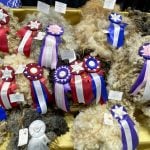Alfalfa regrowth – slow or dead?
Irrigated alfalfa producers in the Swift Current area might attribute slow regrowth this spring to the cold weather. Alfalfa should have about four inches (10 centimetres) of new growth by May but this year has shown no signs of life.
Alfalfa test plots at the Semiarid Prairie Agricultural Research Centre in Swift Current are showing symptoms of winterkill. Rather than assuming the alfalfa is going to regrow when the warm temperatures return, producers should survey their own stands now, before the spring seeding rush, to determine if winterkill has occurred.
Read Also

VIDEO: Green Lightning and Nytro Ag win sustainability innovation award
Nytro Ag Corp and Green Lightning recieved an innovation award at Ag in Motion 2025 for the Green Lightning Nitrogen Machine, which converts atmospheric nitrogen into a plant-usable form.
Here’s a simple method to sample alfalfa plants for winterkill. At several spots in the field, dig individual alfalfa plants with the crown and about six (15 cm) inches of intact taproot. The crown is the region where the stubble (last year’s stems) and the taproot meet. Using a knife, split 20 plants starting at the crown and down the middle of the taproot. Check the color of the root.
If it is white and firm, the root is healthy. If the root is brownish yellow in color, is soft and watery or if the outside of the root peels off the centre part like a banana peel, it has been killed by low temperature.
If there are five or less healthy plants, consider breaking and seeding the field with an annual forage crop as soon as possible.
If there are 15 or more healthy plants, the stand will be thin but yields should recover. Delaying the first harvest until 100 percent bloom will help the survivors recover vigor.
If there are about 10 healthy plants, the stand will be weak and weedy. Breaking will depend on the individual situation but often producers are disappointed with the yield and quality of alfalfa hay from stands that are only half the normal plant density.
If the stand was a mixture of alfalfa and grass, the grass component will produce reasonable forage yield even if the alfalfa plants have winterkilled. Soil testing and fertilizing with nitrogen and phsphorus to recommendations will keep that grass stand producing in the future.
Soil temperatures at or below -20 C can cause winterkill in alfalfa. Snow cover was better than usual during the past winter and soil temperatures at the centre’s weather station did not drop below -15. However, soil temperatures in individual alfalfa fields will vary and some varieties of alfalfa are sensitive to soil temperatures at -15.
Replace depleted supplies
The winter of 1995-96 was a long, cold one and cattle producers fed more hay than usual to carry their cattle through. Irrigated alfalfa hay will be important to replace those feed supplies before next winter because the price of feed barley has shown no signs of coming down in the near future.
It would be disappointing if that first cut of alfalfa turned out to be all weeds. Checking alfalfa stands for winterkill now, before seeding, could save money on that feed bill later.
– Agriculture Canada














